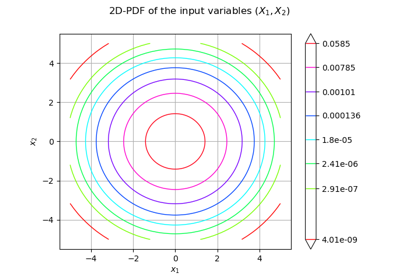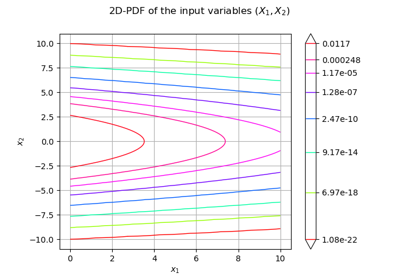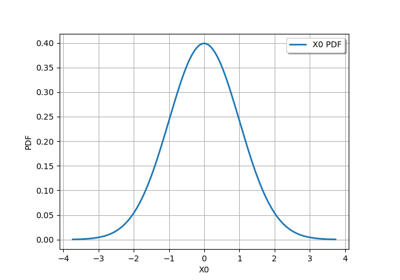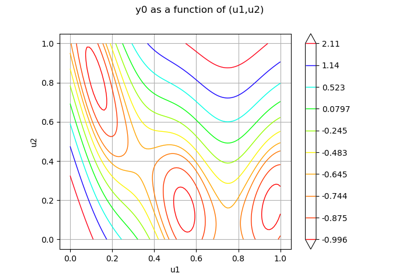Box¶
(Source code, png)

- class Box(*args)¶
Box design of experiments.
- Parameters:
- levelssequence of int or float
Sequence specifying the number of intermediate points in each direction which regularly discretizes a pavement. In direction
, the points number is
.
- bounds
Interval, optional The bounds of the pavement If not specified, the bounds are set to the unit pavement
.
See also
Notes
Box is a stratified design of experiments enabling to create a points grid by regularly discretizing a pavement with the number of intermediate points specified in each direction. The number of points generated is
.
Examples
>>> import openturns as ot >>> # direction 1 will be discretized in with 4 intermediate points >>> # and direction 2 with 2 intermediate points >>> levels = [4, 2] >>> # first component in [5,7], second in [6,9] >>> bounds = ot.Interval([5.0, 6.0], [7.0, 9.0]) >>> myGrid = ot.Box(levels, bounds) >>> mySample = myGrid.generate()
Methods
generate()Generate points according to the type of the experiment.
Get the center of the stratified experiment.
Accessor to the object's name.
Get the levels of the stratified experiment.
getName()Accessor to the object's name.
hasName()Test if the object is named.
setCenter(center)Set the center of the stratified experiment.
setLevels(levels)Set the levels of the stratified experiment.
setName(name)Accessor to the object's name.
- __init__(*args)¶
- generate()¶
Generate points according to the type of the experiment.
- Returns:
- sample
Sample The points which constitute the design of experiments. The sampling method is defined by the nature of the experiment.
- sample
Examples
>>> import openturns as ot >>> ot.RandomGenerator.SetSeed(0) >>> myExperiment = ot.Experiment(ot.MonteCarloExperiment(ot.Normal(2),5)) >>> print(myExperiment.generate()) [ X0 X1 ] 0 : [ 0.608202 -1.26617 ] 1 : [ -0.438266 1.20548 ] 2 : [ -2.18139 0.350042 ] 3 : [ -0.355007 1.43725 ] 4 : [ 0.810668 0.793156 ]
- getCenter()¶
Get the center of the stratified experiment.
- Returns:
- center
Point Sequence which has different meanings according to the nature of the stratified experiment: Axial, Composite, Factorial or Box (see corresponding documentation).
- center
- getClassName()¶
Accessor to the object’s name.
- Returns:
- class_namestr
The object class name (object.__class__.__name__).
- getLevels()¶
Get the levels of the stratified experiment.
- Returns:
- levels
Point Sequence which has different meanings according to the nature of the stratified experiment: Axial, Composite, Factorial or Box (see corresponding documentation).
- levels
- getName()¶
Accessor to the object’s name.
- Returns:
- namestr
The name of the object.
- hasName()¶
Test if the object is named.
- Returns:
- hasNamebool
True if the name is not empty.
- setCenter(center)¶
Set the center of the stratified experiment.
- Parameters:
- centersequence of float
Sequence which has different meanings according to the nature of the stratified experiment: Axial, Composite, Factorial or Box (see corresponding documentation).
- setLevels(levels)¶
Set the levels of the stratified experiment.
- Parameters:
- levelssequence of float
Sequence which has different meanings according to the nature of the stratified experiment: Axial, Composite, Factorial or Box (see corresponding documentation).
- setName(name)¶
Accessor to the object’s name.
- Parameters:
- namestr
The name of the object.
Examples using the class¶

Use the FORM algorithm in case of several design points

An illustrated example of a FORM probability estimate

Using the FORM - SORM algorithms on a nonlinear function
 OpenTURNS
OpenTURNS






